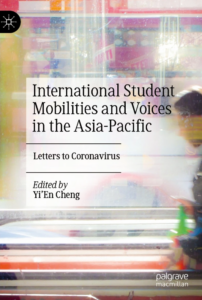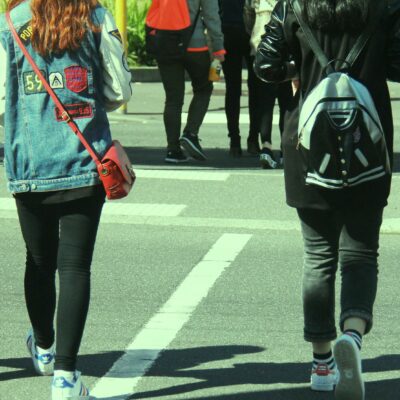
Letters, as materials in the study of migration and settlement as well as a literary form, have been of interest to history and literature. Letters crossing borders, in particular, have been an important part of documenting immigration and resettlement across time and place. Writing letters is a safe textual space which reflects memory, the moment of their production, and ‘the here and now of reading’. With the global COVID-19 pandemic extremely limiting our mobility and disrupting our perception of time, letters are an important individual reflection and representation of the global experience of those trying times.
In the edited volume titled International Student Mobilities and Voices in the Asia-Pacific: Letters to Coronavirus, Yi’En Cheng invites international students, scholars, educators and an artist from different regions of the Asia-Pacific to write a letter ‘to’ the coronavirus. Cheng is a Lecturer at the National University of Singapore whose research focuses on the implications of higher education on young people’s citizenship and their experiences of mobility and immobility.
With 20 letters addressed directly COVID-19, eight commentaries, and eight artworks, Letters to Coronavirus takes us back through the uncertainty, anxiety and immobility of international students’ lives before the first half of 2021. As a way of ‘writing the now’, the letters serve as the starting point of the conversation about mobilities and voices of international students. While these letters would never reach their intended addressee, they arrive in the hands of readers, including scholars and educators, and invite us to delve into additional valuable layers of interpretation of these letters.
Letters to Coronavirus is divided into three parts. The first two parts, Regimes and Experiences, navigate through the notions of (im)mobility during the pandemic. The last part, Aspirations, presents further reflective conversations and aspirational trajectories for the post-pandemic world. There is a comfortable flow in letter tones despite their different approaches: some are personal and open while some are objective and detached making for a dynamic reading experience.
As we progress through Letters to Coronavirus, we encounter not only stories of spatial and temporal challenges of education during the pandemic but also accounts of self-reflection and examples of where the pandemic offered blessings in disguise. Juliet Tingshu Zhu, a Chinese student in Thailand emphasises that the pandemic prompted ‘the longest sojourn of her life’ and helped her understand the spatiotemporal fragility of state borders. Joseph Cing Velasco, a Filipino student in Macau, recounts his experience of transnational mobility disruption at the beginning of the pandemic, reflecting his experience as a form of ‘anxious mobility’. Meanwhile, for Yuri Suzuki, a Japanese student studying in Rotterdam, her immobility in her home country made her realise how the pandemic has also ‘expanded our community in new ways’, offering opportunities to engage more in classes and (virtually) attend events through online platforms. Another letter, written by Mawutor Kwame Ahiabu, a Ghanaian student who was set to study in Indonesia but was forced to remain in his home country, passionately tells us how the pandemic has been ‘a defiant oppressor of our generation’, which directly deprived him of academic excellence and career goals.
One of the strongest points of Letters to Coronavirus is its focus on international students from the Asia-Pacific region, which is home to almost two-thirds of the world’s population and the origin of 40 percent of all international migration, forming the largest group of international or foreign students in tertiary education at all levels. Once considered relatively economically privileged and cosmopolitan, international students found themselves suddenly vulnerable and immobile and became one of the groups most directly affected by the pandemic.
The book provides reflective opportunities to think and rethink about the pandemic from scholarly perspectives and how their spatial and temporal journeys have reshaped their social agency and decision-making power. Cheng has started the journey of, in his words, ‘opening up new areas for enquiry and theoretical consideration for future scholarship’ in pandemic mobility studies. The reflective and critical nature of the letters and commentaries serves as a significant contribution to the field of geography of education, and to the use of qualitative ethnographic methods in research about young people in education.
Being an international student during the pandemic myself, there is a strong sense of familiarity as I read through the students’ letters and commentaries as well as a reminder that we are still in the process of overcoming our losses and fully comprehending the pandemic. Circumstances have changed since the height of COVID-19 and those times and spaces may feel like the distant past. However, Letters to Coronavirus is an important record of those disrupted and suspended time-spaces as experienced by Asia-Pacific international students. With the letters ‘writing the now’, they are also writing for the future, for the further inclusion of international students and for what the students’ experiences have taught us in terms of scholarship and humanity.
Main image credit: Photo by Thomas Willmott on Unsplash. Book cover used with the permission of the publisher.




